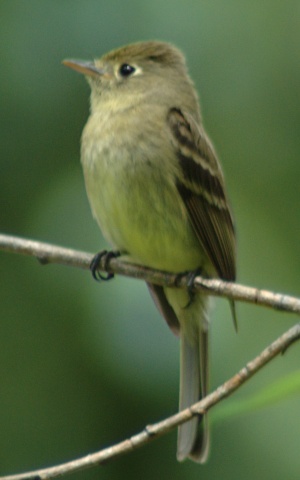Cordilleran flycatcher facts for kids
Quick facts for kids Cordilleran flycatcher |
|
|---|---|
 |
|
| Conservation status | |
| Scientific classification | |
| Genus: |
Empidonax
|
| Species: |
occidentalis
|
The Cordilleran flycatcher (Empidonax occidentalis) is a small bird that eats insects. It is a type of tyrant flycatcher from the Empidonax group. These birds are usually about 13 to 17 centimeters long.
Adult Cordilleran flycatchers have olive-gray feathers on their backs. Their wings and tail are a bit darker. Their bellies are yellowish. They have a clear white ring around each eye, which looks like a teardrop. They also have white bars on their wings, a small beak, and a short tail.
Many birds in the Empidonax group look very similar. It can be hard to tell them apart just by looking! The best ways to identify them are by listening to their songs, knowing where they live and breed, and checking their migration paths.
The Cordilleran flycatcher looks almost exactly like the Pacific-slope flycatcher. These two birds were once thought to be the same species, called the "western flycatcher." But in 1989, scientists at the American Ornithological Society decided they were different species.
The Pacific-slope flycatcher breeds in the forests along the Pacific Coast, from California all the way to Alaska. The Cordilleran flycatcher, however, breeds in the Rocky Mountains. They also have different songs and calls, which helps scientists tell them apart.
Where They Live and Build Nests
Cordilleran flycatchers like to breed in pine and oak forests, or in conifer forests. They usually prefer areas close to running water.
They build their nests in the shape of a cup. These nests are often placed in the fork of a tree branch, usually on a low, horizontal branch. Female flycatchers typically lay two to five eggs.
Migration and Diet
These birds travel south to Mexico for the winter. Some Cordilleran flycatchers that live in central and southern Mexico stay there all year. Other birds from the north migrate to Mexico's western coast, from Jalisco northward. They then move inland into a special wildlife corridor along the western side of the Sierra Madre Occidental mountains.
The Cordilleran flycatcher is a skilled hunter. It waits on an open branch of a bush or a low tree branch. When it sees an insect flying by, it quickly flies out to catch it in mid-air. This hunting style is called hawking. Sometimes, it also picks insects off leaves while hovering, which is called gleaning.
Their Unique Songs
The song of the Cordilleran flycatcher includes notes that sound like pseet, ptsick, and seet. They usually sing these notes quickly together. The ptsick or ptik note is special because its first part is higher-pitched than the second. This is the main difference from the Pacific-slope flycatcher's song.
Male Cordilleran flycatchers also have a loud and clear call that sounds like pit pete or tse-seet. However, some of them make a "rising tsweep" or a "slurred tseeweep" sound, which is similar to the calls of Pacific-slope flycatchers.
See also
 In Spanish: Mosquero del Pacífico para niños
In Spanish: Mosquero del Pacífico para niños


